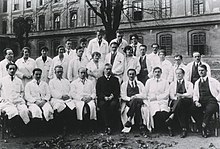Edward Bibring

Photo: Ludwig Gutmann

Edward Bibring (born April 20, 1894 in Stanislau , Austria-Hungary ; died January 11, 1959 in Boston ) was an Austrian-American psychoanalyst .
Life
Edward Bibring attended the boys' grammar school in Chernivtsi and began studying history and philosophy there in 1913. During the First World War he was used on the Eastern Front and in 1915 he was taken prisoner by the Russians. When the Russian Revolution broke out in 1917, he was able to flee and went to Vienna , where he began studying medicine in 1918, which he completed in 1922. In 1919 he worked with his fellow students Otto Fenichel , Wilhelm Reich and Grete Lehner in the founding of a “working group on sexology and psychoanalysis”. He completed a training analysis with Paul Federn . In 1921 he married Grete Lehner , both were invited to the meetings of the Vienna Psychoanalytic Association , of which he became a member in 1925. With his wife he ran a private practice in the 7th district .
In the association he took on various electoral posts and in 1929 he succeeded Paul Schilder as head of the department for psychoses. In 1932 he was elected deputy to Eduard Hitschmann and a member of the teaching committee. In 1934 he joined the editorial team of the International Journal of Psychoanalysis as the successor to Federn .
After Austria's annexation in 1938, the family with their two sons, born in 1929 and 1931, emigrated to England on the collective visa for Sigmund Freud , where he became a member of the British Psychoanalytical Society and practiced as a training analyst at the London Psychoanalytic Institute. He was appointed editor of Freud's collected works. Since he was offered a lectureship at Tufts Medical College in Boston , the family moved to the United States in 1941. Bibring also worked there at the Boston Psychoanalytic Institute and as a doctor at the Psychiatric Clinic of the Beth Israel Hospital Boston.
Bibring had writer's block and was therefore unable to publish very much; his 1954 essay was cited by Joan Didion in 2005 .
Fonts (selection)
- On the development and problematic of drive theory . in: Imago, 1936, pp. 147-176
- The so-called English school of psychoanalysis , in: The psychoanalytic quarterly, 1947, pp. 69-93
- Psychoanalysis and the dynamic psychotherapies , in: Journal of the American Psychoanalytic Association, 1954, pp. 745-770
- Sanford Gifford (ed.): Edward Bibring photographs the psychoanalysts of his time: (1932-1938) . Giessen: Psychosocial, 2005 ISBN 3-89806-412-3
literature
- Elke Mühlleitner: Bibring, Edward , in: Gerhard Stumm , Alfred Pritz, Paul Gumhalter, Nora Nemeskeri, Martin Voracek (ed.): Personal dictionary of psychotherapy . Vienna, New York: Springer, 2005, p. 48f.
- Elke Mühlleitner: Bibring, Edward , in: Biographical Lexicon of Psychoanalysis. The members of the Psychological Wednesday Society and the Vienna Psychoanalytical Association 1902–1938 . Tübingen: Edition Diskord, 1992, ISBN 3-89295-557-3 , p. 41f.
- Werner Röder, Herbert A. Strauss : Biographisches Handbuch der Deutschensprachigen Emigration nach 1933 / International Biographical Dictionary of Central European Emigrés 1933–1945 , Vol II, 1 Munich: Saur 1983 ISBN 3-598-10089-2 , p. 102
Web links
- Literature by and about Edward Bibring in the catalog of the German National Library
- Literature by and about Edward Bibring in the WorldCat bibliographic database
- Edward Bibring , at Psyalpha
Individual evidence
- ^ Joan Didion: The Year of Magical Thought , 6th Edition, 2007, p. 63
| personal data | |
|---|---|
| SURNAME | Bibring, Edward |
| BRIEF DESCRIPTION | Austrian-American psychoanalyst |
| DATE OF BIRTH | April 20, 1894 |
| PLACE OF BIRTH | Stanislau |
| DATE OF DEATH | January 11, 1959 |
| Place of death | Boston |